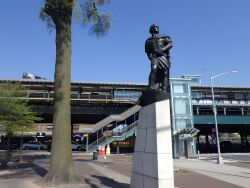Columbus Square
View all monuments in NYC Parks, as well as temporary public art installations on our NYC Public Art Map and Guide.
Christopher Columbus
| Artist: | Angelo Racioppi |
| Dedicated: | October 12, 1941 |
| Location: | Astoria Boulevard, Hoyt Avenue and 31st Street |
Artwork History
In 1473, Christopher Columbus (1451–1506) embarked on his first maritime voyage from his home near Genoa, Italy, headed for the island of Khios in the Aegean Sea. Upon his return in 1476, he traveled in a convoy destined for England. Legend has it that pirates sank Columbus’s ship near the coast of Portugal. Columbus swam to shore and settled in Lisbon, where his brother Bartholomew worked as a cartographer.
Based on speculative maps, Columbus concluded that there was a quicker route to the markets of Asia than was yet known. Instead of heading south and circumnavigating Africa, Columbus proposed to sail west. In the 1480s, he presented this proposal to the monarchs of Portugal and Spain. In April 1492, King Ferdinand V and Queen Isabella of Spain agreed to sponsor Columbus’s proposed voyage. On August 3, 1492, the three modest ships that comprised Columbus’s party, the Nina, the Pinta, and the Santa Maria, set sail. They sighted land on October 12, 1492. The ships landed on Guanahani, an island in the Bahamas. Columbus claimed the land for the King of Spain and renamed the island San Salvador. Believing he had reached the West Indies, Columbus called the natives “los Indios,” or Indians. The members of the expedition returned to Spain triumphantly on March 15, 1493. After receiving a title of nobility, Christopher Columbus immediately launched a larger expedition. On November 3, 1493, this fleet of 17 ships anchored near present day Puerto Rico. His third and fourth voyages set sail in 1498 and 1502.
Columbus's early descriptions of the Americas, as in his “Letter to Luis de Santangel Regarding the First Voyage” (1493), liken the land to an earthly paradise brimming with potential for European colonists. By the time that he sent his “Letter to Ferdinand and Isabella Regarding the Fourth Voyage” (1503), he had been undone by political charges against him, several mutinies, and the realities of his colonizing mission. He died impoverished in Spain in 1506 with his public reputation in tatters. Later, when Americans looked for founder-heroes in the early years of the republic, authors like Washington Irving (The Life and Voyages of Christopher Columbus (1828) documented Columbus’s story. Focusing largely on his arrival in the Americas as opposed to the colonization of the area, Irving and others enshrined Columbus as a hero. His popular reputation ever after became that of the bold, courageous adventurer who enabled American civilization, and he is memorialized here and elsewhere as such.
The City acquired this park in 1910, and the Board of Aldermen named it Columbus Square in 1930. Angelo Racioppi created the bronze statue with funds from the New York City Works Progress Administration Art Project. It depicts a youthful Columbus at the helm of a ship, and it is set on an angular cast stone base suggestive of a boat prow. Dedicated on October 12, 1941, the artwork provoked a public feud between Queens Borough President George U. Harvey and Parks Commissioner Robert Moses (1888-1981).
At a May 1941 meeting of the Board of Estimate in which plans for the statue were discussed, Harvey referred to Moses as an “appointed official who couldn’t be elected as dogcatcher.” Moses responded in a letter, “I have no thought of running against you for dogcatcher. The job is right up your alley.” Later, Moses wrote, “We don’t think the statue looks like anything we have read about Columbus, or that as a piece of symbolism it represents anything associated with Columbus. On the other hand, just as a piece of sculpture without any particular significance, it is not objectionable.” Harvey replied, “Anything Moses doesn’t design himself, he thinks is no good.”
This statue of Columbus is one of five located in New York City parks; the others are in Central Park and Columbus Circle, Manhattan, Columbus Park, Brooklyn, and D’Auria Murphy Park in the Bronx. The park and monument are often the focal point of the local Columbus Day parade and attendant festivities.
Artwork Details
| Description: | Standing figure (over life size) on pedestal, on plinth |
| Materials: | Figure--bronze; Pedestal and plinth--cast stone |
| Dimensions: | Figure H: 7'6" W: 4' D: 4' |
| Donor: | New York City Works Progress Administration art project |
| Cast: | 1941 |
Inscription
COLUMBUS / 1451-1506Please note, the NAME field includes a primary designation as well as alternate namingsoften in common or popular usage. The DEDICATED field refers to the most recent dedication, most often, butnot necessarily the original dedication date. If the monument did not have a formal dedication, the yearlisted reflects the date of installation.
For more information, please contact Art & Antiquities at (212) 360-8163.
Check out your park's Vital Signs
Clean & Safe
Green & Resilient
Empowered & Engaged Users
Share your feedback or learn more about how this park is part of a
Vital Park System




